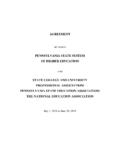Transcription of Effect of Collective Bargaining on Strikes and Wages
1 Forthcoming Review of Economics and Statistics, 1999. The Effect of Collective Bargaining Legislation on Strikes and Wages Peter Cramton, Morley Gunderson, and Joseph Tracy*. University of Maryland, University of Toronto, and Federal Reserve Bank of NY. 25 May 1999. Abstract Using Canadian data on large, private-sector contract negotiations from January 1967 to March 1993, we find that Strikes and Wages are substantially influenced by labor policy. The data indicate that conciliation policies have largely been ineffective in reducing strike costs. In contrast, general contract reopener provisions appear to make both unions and employers better off by reducing negotiation costs without systematically affecting wage settlements. Legislation banning the use of replacement workers appears to lead to significantly higher negotiation costs and redistribution of quasi-rents from employers to unions. *We have benefitted from comments by two referees and seminar participants at Johns Hopkins University, Stanford University, the University of Maryland, the University of Montreal, and the University of Wisconsin.
2 We are particularly grateful to John Budd of the University of Minnesota for helpful suggestions and for providing us his coding of policy variables based on an examination of the original statutes. Financial support is gratefully acknowledged from the National Science Foundation for Cramton and Tracy and a Social Sciences and Humanities Grant for Gunderson. Most of this work was completed while Cramton was a National Fellow at the Hoover Institution, Stanford University, and Gunderson was visiting the National Bureau of Economic Research, Stanford, California. The views expressed in this paper are those of the authors and are not necessarily reflective of views at the Federal Reserve Bank of New York or the Federal Reserve System. JEL Classifications: D82, J52, J58. Introduction In this paper, we investigate the Effect that Collective Bargaining legislation has on strike incidence, strike duration, and wage outcomes. From a policy perspective, it is important to assess whether labor legislation has its intended effects on Bargaining outcomes.
3 Often, Collective Bargaining legislation is enacted to improve the efficiency of negotiations, for example by reducing the incidence and duration of Strikes . We evaluate the extent to which these policies are effective at reducing strike activity. Variations in the Bargaining rules as determined by labor legislation are also likely to influence the balance of power between the union and the firm, and hence affect wage settlements. Indeed, the primary motivation of advocates of a particular legislative initiative may be distributional, even when their stated intentions are to improve efficiency. For this reason, we analyze the wage effects and potential welfare consequences of the various labor policies. We utilize a data set that includes all private-sector contract negotiations in Canada involving 500. or more workers from January 1967 to March 1993. Canada is a good setting to carry out this type of study. First, its labor law is determined mainly at the provincial level, rather than the national level.
4 Hence, there is variation in labor policy both among the provinces at a point in time and within provinces over time. Second, Canadian data are systematically collected through mandatory reporting requirements which should increase data reliability. We find that conciliation policies have been largely ineffective in reducing strike costs. In contrast, general contract reopener provisions appear to make both unions and employers better off by reducing negotiation costs without systematically affecting wage settlements. Legislation banning the use of replacement workers leads to higher negotiation costs both by increasing the frequency and duration of Strikes . In addition, replacement bans also result in significantly higher real wage settlements. The estimated average cost to employers from a replacement ban is around $ million (1993 Canadian). dollars per contract. We present our theoretical perspective and a description of the key Canadian Collective Bargaining legislation in the next section.
5 In section 3 we describe our data more fully. Section 4 discusses the effects of labor policy on strike incidence, strike duration, and Wages . Section 5 compares our results to the earlier literature. In section 6, we calculate the welfare implications of Bargaining legislation for unions and employers. 2 Canadian Labor Legislation A Theoretical Perspective In this section, we briefly outline the structure of a Bargaining model of labor negotiations. We use this model to help frame predictions for various Canadian Collective Bargaining legislation. For each type of legislation, we describe the nature, intent, and likely Effect on strike activity and wage settlements. A Precis on Strategic Bargaining Models A detailed exposition of our theoretical wage Bargaining model appears in Cramton and Tracy (1992, 1994a).1 The union and firm are negotiating the wage to be paid over the life of the contract. The firm has private information about its willingness to pay. Offers are exchanged until a settlement is reached.
6 Prior to settlement, the parties receive their threat payoffs. In the simplest model, the union decides between two possible threats the union can strike or it can apply pressure on the firm while continuing to work under the expired contract, which we call holdout. The threat payoff to the union under a holdout is the wage from the expired contract. The settlement wage consists of the union'sthreat payoff plus a share of the inefficiencies induced by the threat (the pie ).The union Strikes if the higher Bargaining costs associated with a strike are more than made up for by a higher expected settlement wage. If the wage under the expired contract is sufficiently high, this is not the case and the union prefers the holdout threat. Policies that reduce the size of the pie should reduce settlement Wages , while policies that increase the attractiveness of the strike threat to the union should increase settlement Wages . Dispute activity ( Strikes and holdouts) occurs because of the union's uncertainty about the firm's willingness to pay.
7 The firm has an incentive to falsely claim that times are tough and therefore a low settlement wage is appropriate. The firm'swillingness to endure a costly strike or holdout is one means of convincing the union to accept a lower wage. Testing this prediction is difficult since we do not observe the parties'private information. Some of the predictions change when the model is extended to allow for time-varying threat payoffs (Cramton and Tracy 1994b). Threat payoffs change over time as replacement workers are hired and trained, as strikers find temporary jobs, as inventories or strike funds run out, or as public assistance to strikers varies based on the length of the strike . A basic finding is that if dispute costs increase in the long 1. See Kennan and Wilson (1989, 1993) for surveys of Bargaining theory and its relation to strike data. 2. run, then dispute durations are longer and Wages decline more slowly during the short run (and may even increase).2. The theory provides structure for empirical models of strike activity and wage settlements.
8 Measures of strike activity should depend on the union'suncertainty regarding the firm'swillingness to pay and variables reflecting the relative attractiveness of the strike and the holdout threats. Wage settlements should depend on the wage under the expired contract (since that is the union'sthreat value under a holdout), determinants of the union'sthreat value during a strike , and factors that affect the inefficiencies resulting from the labor dispute. Canadian Labor Legislation Since the legislated policy variables are the focus of the analysis they merit extended discussion. Compulsory conciliation is a form of third-party intervention by a government appointed official that is required after the contract has expired and before a strike can occur. The aim is to improve the efficiency of Bargaining by reducing strike activity. Conciliation can be a one-step procedure involving a conciliation officer who acts as a catalyst to try to help the parties resolve the dispute.
9 If a settlement does not occur, the officer reports to the Minister of Labour indicating the items that have been agreed upon, and those which are still in dispute. In some jurisdictions a two-step procedure involving both a conciliation officer and a board is required. The board is tripartite with a neutral chair and a representative of labor and of management. The board has a more normative role, since its recommendations are made public, with the intent of putting added pressure on the parties to settle. While the conciliation process is intended to facilitate Bargaining and to cool-down the negotiations, it has often been characterized as an impediment to direct serious Bargaining which creates delays that heat up the negotiations and allow the parties to prepare for an eventual strike [Craig, 1983 p. 189]. Bargaining models would predict a reduction in strike activity if on balance conciliation improves the 2. Dispute duration is determined by the firm equating the marginal benefit of waiting (a lower wage).
10 With the marginal cost of waiting (additional dispute costs). An increase in long run dispute costs magnifies the dispersion of wage settlements between the high value employers (who settle early) and the low value employers (who settle late). Hence, the overall incentive for signaling a low value increases with the long run dispute cost, but the dispute cost in the short run is constant, so the dispute duration must increase to balance the costs and benefits of waiting to signal a low value. 3. information flow between the union and the firm. Conciliation is intended to be neutral with respect to wage settlements. Many jurisdictions require a cooling-off period after conciliation (if required) has concluded, and before a strike can begin. The intent is to give the parties one last chance to reconcile their differences before Bargaining costs begin to escalate. Cooling-off periods can be viewed as a period of dispute where the union can exercise only the holdout threat.

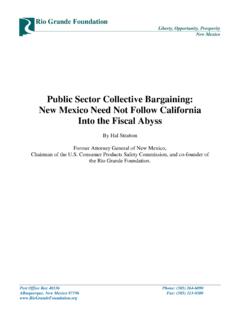
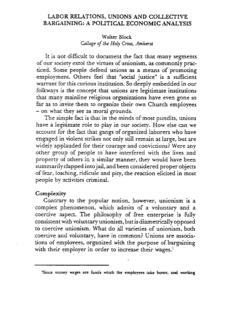
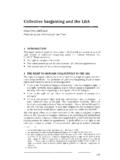
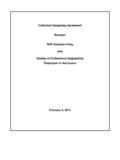
![PROTECTIVE SERVICES [NP-5] BARGAINING UNIT …](/cache/preview/6/c/f/6/f/1/1/4/thumb-6cf6f1149d89c2f122cf7097d1d511b9.jpg)



